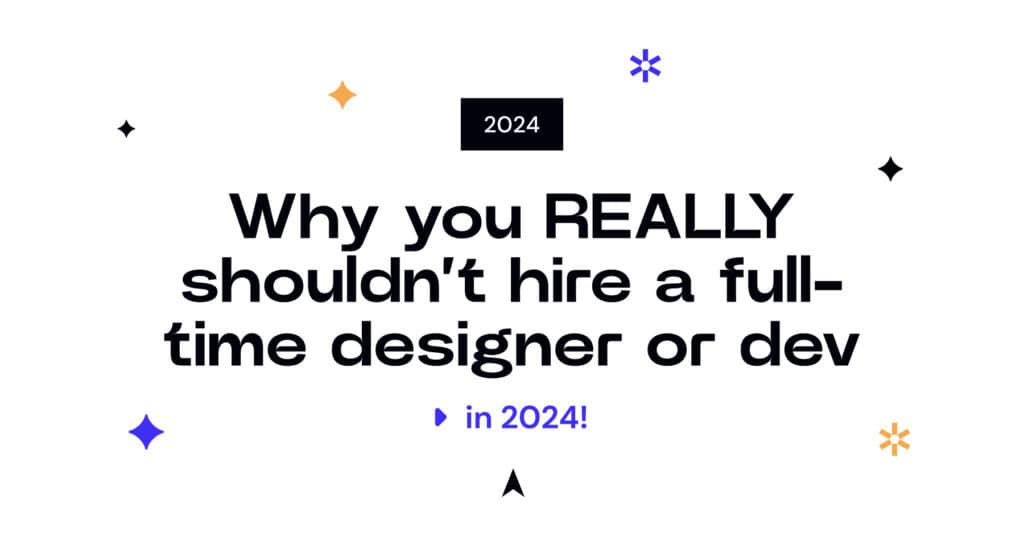When starting out as a web designer, deciding what to charge for web design can be tricky. You don’t want to charge too much and scare away new clients, but you can’t afford to charge too little because you need to make enough to sustain yourself. This dichotomy often puts web designers into one of these two camps, but finding a happy medium is actually the goal.
There are many lessons to be learned the hard way when figuring out what to charge for web design. So, instead of leaving you to learn lessons through lost clients or thin wallets, we’ve decided to put together the ultimate web design pricing guide.
In this guide, we will discuss the best ways to price your work as a web designer, no matter what skill level you are currently at. We’ll include the do’s and do not’s to pricing and the keys to how to value yourself, your work, and your business.

Be Honest About Your Experience
“How much should a website designer charge?” is one of the most common questions web designers and their clients ask themselves.
First and foremost, web design pricing has an element of relation to skill and experience. This correlation is by design – clients who know about web design have expectations for pricing ranges and the skill level of their designers. There is quite an income range for web designers, with entry-level web designers earning 3.5 times less than their expert counterparts in the United States.
Expert web designers are able to offer speed, features, and expertise that entry-level web designers are not yet prepared to provide their clients. These experts can justify their higher prices as a result, while those with thinner portfolios may not be able to do so. Thus, pricing your work at an expert range while you are a newcomer can discourage clients from hiring you and waste your time waiting for clients to come to you.
However, the opposite is also true! It can be difficult to self-assess yourself, but pricing yourself according to your experience, knowledge, and toolkit is imperative. To do so, research other designers who feature portfolios similar to you. This research can help you to determine if you are undervaluing or overvaluing yourself in relation to other designers.
Make sure that your portfolio is easily available for clients, too! If you have only a couple of years of experience but produce high-quality work outside of entry-level skills, your clients will need to see it to believe it through your portfolio. A great web design portfolio is one of the best ways for you to show off your skills and justify your pricing to prospective customers.

Charge What Your Work is Worth (At Least!)
On the other hand, web designers who work independently or on a freelance basis fall into the trap of charging less just to lure in new clients. However, the most important thing to remember about setting your prices is: Don’t work for less than you are worth. But additionally, charge clients for your work for what its value is. Web design has an invaluable effect on businesses and projects.
With a gorgeous, efficient website, your clients will be able to sign on clients of their own – that is to say, your work as a web designer is significant! Creating higher conversion rates for a business generates substantial value for companies. Even better, well-designed websites last for years into the future, which can make the value of a website worth $20,000 plus, depending on the increased conversion for the company
…And Never Charge Less in the Hope of More Clients
You’ve spent the time learning how to do your job and do it well. By charging lower than your work is worth, you might end up taking on more clients in the short term, but you risk giving away work for free. This process can be incredibly draining. Freelancers who do this often end up burnt out with too much work on their plate that they are not getting paid properly for.
Not only can charging clients less make you feel like you are working for free, but it also places less value on your work for yourself. This creates a bad relationship between you and work. You start to resent your clients for paying you so little, even though you set your prices that way. Further, you can actually lure in lower-quality clients with your low prices.
You are more likely to come across clients that are cheap and similarly place low value on your work because by having low prices – you’ve told them to. Instead, be confident in your ability to deliver high-quality work at the value in which your work is.
Stay Away From Hourly Pricing
While it is important to track what you’re making per hour to make sure you are making enough to sustain yourself, your clients don’t need to know how many hours you are working. As you develop your skills as a web designer, you will move through projects faster. Just because you start to complete tasks faster doesn’t mean that the value of your work is lesser. This phenomenon is something that hourly web designers quickly come to regret when taking on clients with hourly pricing.
When the day comes when you begin to complete projects in less time, you don’t want to punish yourself financially as a result. Your skills took you years to learn and should be rewarded similarly to other professions that require diligent studying to rise to the top. Just because you work faster doesn’t mean you should earn less!
Hourly Pricing Invites Questions About Your Pricing
Hourly pricing also makes those who are less tech-savvy wonder what the heck you’re doing on their dime. Many clients don’t understand the ins and outs of web design. They don’t know the time it takes to generate an eye for design, nor the amount of time it takes to learn the programs you need to learn to complete projects.
Those who aren’t familiar with web design especially don’t understand how long certain tasks take to complete, and hourly pricing calls into question what you are spending time on while completing their projects. Instead, flat rate pricing raises fewer eyebrows and allows you to value your work by task rather than by time.
Other reasons to choose flat rate pricing include:
- Allows businesses to budget for web design easier.
- Clients have a clearer picture of what they will pay you.
- Cuts out time in the consulting stage due to transparency.
- Rewards you for completing work sooner.
- Results in more satisfied clients.
For more information on why flat rate pricing is the preferred method for small or independent businesses, Quickbooks has incredible information about how hourly billing has negative impacts on accounting.

Web Design Pricing Based on Individual Projects
Web design often isn’t a cut-and-dry flat rate. There are many circumstances that can dictate that you may need to charge more or less depending on the complexity of the project. You may come across a project from a large company that wants to rebuild its website from the ground up and improve its conversion rates. Another small company might simply want you to rework its existing home page.
These two example projects are drastically different workloads and should have significantly different pricing. This is to protect yourself from doing unpaid work, as any web designer knows that building a custom website completely from scratch is far different than changing fonts and color schemes on one page.
Build in revisions, reworks, and consultations into your pricing schemes, and ensure that you are making a living wage on each project that you take on. Think about the additional resources you might need – animators, copywriters, photographers, videographers, or developers. These add-ons must be built into your pricing because they are expenses.
While this might mean you need to give individual quotes to clients, taking a personalized approach to web design pricing will help protect yourself and the value of your work and be transparent when doing so.
Conclusion
I hope we were able to help you now whenever you ask yourself “How much should I charge for website design?” and how website design pricing works.
There are many aspects that can change your pricing, but we hope that we have illuminated some of the things that you should and should not do when setting your web design pricing. At UI Rocket, we believe that web designers should be paid their worth. Your hard work is worth the money your clients will pay you. Additionally, your portfolio will speak for itself!
The right clients will value your time and efforts as long as you price yourself appropriately for your skill and experience. Any other pricing shortcuts you may make will only hurt you in the long term. So, charge what you’re worth and treat projects as individual jobs rather than lowering prices in an effort to attract more business in the short term. And, most importantly, value your work so that your clients will too!
Do you have additional questions about how to charge web design and web design pricing? Comment below or contact us for more information!






